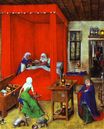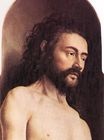Jan van Eyck - Eve, from the right wing of the Ghent Altarpiece 1425-1429
 |
 |
 |
 |
 |
 |
 |

Eve, from the right wing
of the Ghent Altarpiece 1425-1429
oil on wood
St. Bavo Cathedral,
Ghent, Belgium
From Wikipedia, the free encyclopedia:
The Ghent Altarpiece (or the Adoration of the Mystic Lamb, Dutch: Het Lam Gods) is a very large and complex 15th-century polyptych altarpiece in St Bavo's Cathedral, Ghent, Belgium. It was begun c. the mid-1420s and completed before 1432, and is attributed to the Early Netherlandish painters and brothers Hubert and Jan van Eyck. The altarpiece is considered a masterpiece of European art and one of the world's treasures.
The two outer panels show near life-sized nudes of Adam and Eve standing in niches. They are the earliest treatment in art of the human nude with Early Netherlandish naturalism, and are almost exactly contemporary with the equally ground-breaking pair in Masaccio's Expulsion from the Garden of Eden in Florence of about 1425. They face inwards towards the angels and the Deësis, separating them. They self-consciously attempt to cover their nakedness with a fig leaf as in the Genesis account, indicating that they are depicted as after the fall of man. Eve holds a fruit in her raised right hand; not the traditional apple but a small citrus, most probably a citron. Erwin Panofsky drew particular attention to this element, and described it as emblematic of the "disguised" symbolism he saw running through the work as a whole. Both figures' eyes are downcast and they appear to have forlorn expressions. Their apparent sadness has led many art historians to wonder about van Eyck's intention in this portrayal. Some have questioned if they are ashamed of their committal of original sin, or dismayed at the world they now look upon.
The realism with which Jan approached his figures is especially evident in these two panels. The depiction of Eve exemplifies the Late Gothic ideal for the female figure, as developed in International Gothic art around the start of the century, and pioneered in nude form by the Limbourg brothers, especially their Adam and Eve in the Très Riches Heures du Duc de Berry. Comparing the Limbourg's Eve to a classical female nude, Kenneth Clark observed that "her pelvis is wider, her chest narrower, her waist higher; above all there is the prominence given to her stomach". Clark describes her as "a proof of how minutely 'realistic' a great artist may be in the rendering of details, and yet subordinate the whole to an ideal form. Hers is the supreme example of the bulb-like body. The weight-bearing leg is concealed, and the body is so contrived that on one side is the long curve of the stomach, on the other downward sweep of the thigh, uninterrupted by any articulation of bone or muscle."
Eve holding a citrus fruit
The precision and detail with which their nakedness is recorded offended many over the years. During a visit to the cathedral in 1781, Emperor Joseph II found them so disagreeable that he demanded they be removed. The couple's nakedness further offended 19th century sensibilities, when their presence in a church came to be considered unacceptable. The panels were replaced by reproductions in which the figures were dressed in skin cloth; these are still on display in the Saint Bavo Cathedral. In comparison to contemporary depictions of Adam and Eve, this version is very spare and omits the usual motifs associated with the theme; there is no serpent, tree or any trace of the garden of Eden normally found in contemporary paintings.
In contrast to the other panels in the register, Adam and Eve are positioned near the edge of each panel, and neither is entirely within the border of their setting. Adam's foot appears to protrude out of the niche and frame and into real space. More subtly, Eve's arm, shoulder and hip appear to extend beyond her architectural setting. These elements give the panel a three-dimensional aspect. The trompe-l'œil become more pronounced when the wings are turned slightly inwards, an especially interesting fact when it is considered that the polyptych was wider than the original chapel it was executed for and could never be opened fully.
Above Adam is a grisaille depiction of Abel making a sacrifice of the first lamb of his flock and Cain presenting part of his crops as a farmer to the Lord. Above Eve is a representation of the murder of Abel by his brother Cain with an ass's jawbone.